Anion Effect on Forward Osmosis Performance of Tetrabutylphosphonium-Based Draw Solute Having a Lower Critical Solution Temperature
Abstract
1. Introduction
2. Materials and Methods
2.1. Materials
2.2. Preparation of Phosphonium-Based ILs
2.3. FO Performance
2.4. Instruments
3. Results and Discussion
3.1. Synthesis and Characterization of Phosphonium-Based ILs
3.2. Electrical Conductivity
3.3. Osmotic Pressure
3.4. Thermo-Responsive Property
3.5. Contact Angle of [P4444][MBS] on the FO Membrane
3.6. Water Flux (Jw) and Reverse Solute Flux (Js) of [P4444][MBS]
3.7. Recyclability Study of [P4444][MBS]
4. Conclusions
Author Contributions
Funding
Institutional Review Board Statement
Informed Consent Statement
Data Availability Statement
Acknowledgments
Conflicts of Interest
References
- Dolan, F.; Lamontagne, J.; Link, R.; Hejazi, M.; Reed, P.; Edmonds, J. Evaluating the Economic Impact of Water Scarcity in a Changing World. Nat. Commun. 2021, 12, 1915. [Google Scholar] [CrossRef] [PubMed]
- Mekonnen, M.M.; Hoekstra, A.Y. Four Billion People Facing Severe Water Scarcity. Sci. Adv. 2016, 2, e1500323. [Google Scholar] [CrossRef] [PubMed]
- Elimelech, M.; Phillip, W.A. The Future of Seawater Desalination: Energy, Technology, and The Environment. Science 2011, 333, 712–717. [Google Scholar] [CrossRef] [PubMed]
- Coday, B.D.; Yaffe, B.G.; Xu, P.; Cath, T.Y. Rejection of Trace Organic Compounds by Forward Osmosis Membranes: A Literature Review. Environ. Sci. Technol. 2014, 48, 3612–3624. [Google Scholar] [CrossRef] [PubMed]
- Linares, R.V.; Li, Z.; Sarp, S.; Bucs, S.S.; Amy, G.; Vrouwenvelder, J.S. Forward Osmosis Niches in Seawater Desalination and Wastewater Reuse. Water Res. 2014, 66, 122–139. [Google Scholar] [CrossRef]
- Wilf, M. Future of the Osmotic Processes. Desalin. Water Treat. 2010, 15, 292–298. [Google Scholar] [CrossRef]
- Cath, T.Y.; Childress, A.E.; Elimelech, M. Forward Osmosis: Principles, Applications, and Recent Developments. J. Membr. Sci. 2006, 281, 70–87. [Google Scholar] [CrossRef]
- Suwaileh, W.; Pathak, N.; Shon, H.; Hilal, N. Forward Osmosis Membranes and Processes: A Comprehensive Review of Research Trends and Future Outlook. Desalination 2020, 485, 114455. [Google Scholar] [CrossRef]
- Kwan, S.E.; Bar-Zeev, E.; Elimelech, M. Biofouling in Forward Osmosis and Reverse Osmosis: Measurements and Mechanisms. J. Membr. Sci. 2015, 493, 703–708. [Google Scholar] [CrossRef]
- Xie, M.; Lee, J.; Nghiem, L.D.; Elimelech, M. Role of Pressure in Organic Fouling in Forward Osmosis and Reverse Osmosis. J. Membr. Sci. 2015, 493, 748–754. [Google Scholar] [CrossRef]
- Kim, Y.; Elimelech, M.; Shon, H.K.; Hong, S. Combined Organic and Colloidal Fouling in Forward Osmosis: Fouling Reversibility and the Role of Applied Pressure. J. Membr. Sci. 2014, 460, 206–212. [Google Scholar] [CrossRef]
- Johnson, D.J.; Suwaileh, W.A.; Mohammed, A.W.; Hilal, N. Osmotic’s Potential: An Overview of Draw Solutes for Forward Osmosis. Desalination 2018, 434, 100–120. [Google Scholar] [CrossRef]
- Takahashi, T.; Akiya, K.; Niizeki, T.; Matsumoto, M.; Hoshina, T. Tunable Thermoresponsive UCST–Type Alkylimidazolium Ionic Liquids as a Draw Solution in the Forward Osmosis Process. Colloids Surf. Physicochem. Eng. Asp. 2022, 639, 128372. [Google Scholar] [CrossRef]
- Chung, T.; Li, X.; Ong, R.C.; Ge, Q.; Wang, H.; Han, G. Emerging Forward Osmosis (FO) Technologies and Challenges Ahead for Clean Water and Clean Energy Applications. Curr. Opin. 2012, 1, 246–257. [Google Scholar] [CrossRef]
- Phuntsho, S.; Shon, H.K.; Hong, S.; Lee, S.; Vigneswaran, S. A Novel Low Energy Fertilizer Driven Forward Osmosis Desalination for Direct Fertigation: Evaluating the Performance of Fertilizer Draw Solutions. J. Membr. Sci. 2011, 375, 172–181. [Google Scholar] [CrossRef]
- Lutchmiah, K.; Lauber, L.; Roest, K.; Harmsen, D.J.; Post, J.W.; Rietveld, L.C.; van Lier, J.B.; Cornelissen, E.R. Zwitterions as Alternative Draw Solutions in Forward Osmosis for Application in Wastewater Reclamation. J. Membr. Sci. 2014, 460, 82–90. [Google Scholar] [CrossRef]
- Nguyen, H.T.; Chen, S.; Nguyen, N.C.; Ngo, H.H.; Guo, W.; Li, C. Exploring an Innovative Surfactant and Phosphate-Based Draw Solution for Forward Osmosis Desalination. J. Membr. Sci. 2015, 489, 212–219. [Google Scholar] [CrossRef]
- Ju, C.; Kang, H. Zwitterionic Polymers Showing Upper Critical Solution Temperature Behavior as Draw Solutes for Forward Osmosis. RSC Adv. 2017, 7, 56426–56432. [Google Scholar] [CrossRef]
- Bai, Y.; Liang, Y.N.; Hu, X. An Eco-Friendly Approach for Heavy Metal Adsorbent Regeneration using CO2-Responsive Molecular Octopus. Chemosphere 2017, 185, 1157–1163. [Google Scholar] [CrossRef]
- Park, S.Y.; Ahn, H.; Chung, J.W.; Kwak, S. Magnetic Core-Hydrophilic Shell Nanosphere as Stability-Enhanced Draw Solute for Forward Osmosis (FO) Application. Desalination 2016, 397, 22–29. [Google Scholar] [CrossRef]
- Kim, J.; Chung, J.; Kang, H.; Yu, Y.A.; Choi, W.J.; Kim, H.J.; Lee, J. Thermo-Responsive Copolymers with Ionic Group as Novel Draw Solutes for Forward Osmosis Processes. Macromol. Res. 2014, 22, 963–970. [Google Scholar] [CrossRef]
- Wu, Y.; Liu, Y.; Chen, R.; Zhang, W.; Ge, Q. A pH-Responsive Supramolecular Draw Solute that Achieves High-Performance in Arsenic Removal Via Forward Osmosis. Water Res. 2019, 165, 114993. [Google Scholar] [CrossRef] [PubMed]
- Riabtseva, A.; Ellis, S.N.; Champagne, P.; Jessop, P.G.; Cunningham, M.F. CO2-Responsive Branched Polymers for Forward Osmosis Applications: The Effect of Branching on Draw Solute Properties. Ind. Eng. Chem. Res. 2021, 60, 9807–9816. [Google Scholar] [CrossRef]
- Ellis, S.N.; Riabtseva, A.; Dykeman, R.R.; Hargreaves, S.; Robert, T.; Champagne, P.; Cunningham, M.F.; Jessop, P.G. Nitrogen Rich CO2-Responsive Polymers as Forward Osmosis Draw Solutes. Ind. Eng. Chem. Res. 2019, 58, 22579–22586. [Google Scholar] [CrossRef]
- Cui, H.; Zhang, H.; Yu, M.; Yang, F. Performance Evaluation of Electric-Responsive Hydrogels as Draw Agent in Forward Osmosis Desalination. Desalination 2018, 426, 118–126. [Google Scholar] [CrossRef]
- MingáLing, M. Facile Synthesis of Thermosensitive Magnetic Nanoparticles as “smart” Draw Solutes in Forward Osmosis. Chem. Commun. 2011, 47, 10788–10790. [Google Scholar]
- Fresnais, J.; Yan, M.; Courtois, J.; Bostelmann, T.; Bée, A.; Berret, J. Poly (Acrylic Acid)-Coated Iron Oxide Nanoparticles: Quantitative Evaluation of the Coating Properties and Applications for the Removal of a Pollutant Dye. J. Colloid Interface Sci. 2013, 395, 24–30. [Google Scholar] [CrossRef]
- Zhao, Q.; Chen, N.; Zhao, D.; Lu, X. Thermoresponsive Magnetic Nanoparticles for Seawater Desalination. ACS Appl. Mater. Interfaces 2013, 5, 11453–11461. [Google Scholar] [CrossRef]
- Cai, Y. A Critical Review on Draw Solutes Development for Forward Osmosis. Desalination 2016, 391, 16–29. [Google Scholar] [CrossRef]
- Cai, Y.; Shen, W.; Wei, J.; Chong, T.H.; Wang, R.; Krantz, W.B.; Fane, A.G.; Hu, X. Energy-Efficient Desalination by Forward Osmosis using Responsive Ionic Liquid Draw Solutes. Environ. Sci. Water Res. Technol. 2015, 1, 341–347. [Google Scholar] [CrossRef]
- Nakayama, D.; Mok, Y.; Noh, M.; Park, J.; Kang, S.; Lee, Y. Lower Critical Solution Temperature (LCST) Phase Separation of Glycol Ethers for Forward Osmotic Control. Phys. Chem. Chem. Phys. 2014, 16, 5319–5325. [Google Scholar] [CrossRef]
- Li, D.; Zhang, X.; Yao, J.; Simon, G.P.; Wang, H. Stimuli-Responsive Polymer Hydrogels as a New Class of Draw Agent for Forward Osmosis Desalination. Chem. Commun. 2011, 47, 1710–1712. [Google Scholar] [CrossRef]
- Shakeri, A.; Salehi, H.; Taghvay Nakhjiri, M.; Shakeri, E.; Khankeshipour, N.; Ghorbani, F. Carboxymethylcellulose-Quaternary Graphene Oxide Nanocomposite Polymer Hydrogel as a Biodegradable Draw Agent for Osmotic Water Treatment Process. Cellulose 2019, 26, 1841–1853. [Google Scholar] [CrossRef]
- Kim, T.; Ju, C.; Park, C.; Kang, H. Polymer having Dicationic Structure in Dumbbell Shape for Forward Osmosis Process. Polymers 2019, 11, 571. [Google Scholar] [CrossRef]
- Endo, T.; Sunada, K.; Sumida, H.; Kimura, Y. Origin of Low Melting Point of Ionic Liquids: Dominant Role of Entropy. Chem. Sci. 2022, 13, 7560–7565. [Google Scholar] [CrossRef]
- Kokorin, A. Ionic Liquids: Theory, Properties, New Approaches; BoD—Books on Demand: Norderstedt, Germany, 2011. [Google Scholar]
- Wilkes, J.S.; Zaworotko, M.J. Air and Water Stable 1-Ethyl-3-Methylimidazolium Based Ionic Liquids. J. Chem. Soc. Chem. Commun. 1992, 965–967. [Google Scholar] [CrossRef]
- Welton, T. Room-Temperature Ionic Liquids. Solvents for Synthesis and Catalysis. Chem. Rev. 1999, 99, 2071–2084. [Google Scholar] [CrossRef]
- Plechkova, N.V.; Seddon, K.R. Applications of Ionic Liquids in the Chemical Industry. Chem. Soc. Rev. 2008, 37, 123–150. [Google Scholar] [CrossRef]
- Wasserscheid, P.; Welton, T. Ionic Liquids in Synthesis; Wiley Online Library: Hoboken, NJ, USA, 2008. [Google Scholar]
- Miao, W.; Chan, T.H. Ionic-Liquid-Supported Synthesis: A Novel Liquid-Phase Strategy for Organic Synthesis. Acc. Chem. Res. 2006, 39, 897–908. [Google Scholar] [CrossRef]
- Cui, J.; Li, Y.; Chen, D.; Zhan, T.; Zhang, K. Ionic Liquid-based Stimuli-responsive Functional Materials. Adv. Funct. Mater. 2020, 30, 2005522. [Google Scholar] [CrossRef]
- Abdullah, M.; Man, M.S.; Abdullah, S.B.; Saufi, S.M. Synthesis and Characterization of Thermo-Responsive Ionic Liquids (TRILs). IOP Conf. Ser. Mater. Sci. Eng. 2020, 736, 042027. [Google Scholar] [CrossRef]
- Qiao, Y.; Ma, W.; Theyssen, N.; Chen, C.; Hou, Z. Temperature-Responsive Ionic Liquids: Fundamental Behaviors and Catalytic Applications. Chem. Rev. 2017, 117, 6881–6928. [Google Scholar] [CrossRef] [PubMed]
- Zeweldi, H.G.; Bendoy, A.P.; Park, M.J.; Shon, H.K.; Kim, H.; Johnson, E.M.; Kim, H.; Lee, S.; Chung, W.; Nisola, G.M. Tetrabutylammonium 2, 4, 6-Trimethylbenzenesulfonate as an Effective and Regenerable Thermo-Responsive Ionic Liquid Drawing Agent in Forward Osmosis for Seawater Desalination. Desalination 2020, 495, 114635. [Google Scholar] [CrossRef]
- Nyan, P.S.; Saufi, S.M.; Abdullah, S.B.; Seman, M.N.A.; Taib, M.M. Tetrabutylphosphonium Trifluoroacetate ([P4444] CF3COO) Thermoresponsive Ionic Liquid as a Draw Solution for Forward Osmosis Process. Malays. J. Anal. Sci. 2018, 22, 605–611. [Google Scholar]
- Abdullah, M.A.M.; Seman, M.N.A.; Chik, S.M.S.T.; Abdullah, S.B. Factorial Design in Optimizing Parameters for Thermoresponsive Ionic Liquids as Draw Solution. Process Saf. Environ. Prot. 2022, 161, 34–49. [Google Scholar] [CrossRef]
- Zeweldi, H.G.; Limjuco, L.A.; Bendoy, A.P.; Kim, H.; Park, M.J.; Shon, H.K.; Johnson, E.M.; Lee, H.; Chung, W.; Nisola, G.M. The Potential of Monocationic Imidazolium-, Phosphonium-, and Ammonium-Based Hydrophilic Ionic Liquids as Draw Solutes for Forward Osmosis. Desalination 2018, 444, 94–106. [Google Scholar] [CrossRef]
- Zhong, Y.; Feng, X.; Chen, W.; Wang, X.; Huang, K.; Gnanou, Y.; Lai, Z. Using UCST Ionic Liquid as a Draw Solute in Forward Osmosis to Treat High-Salinity Water. Environ. Sci. Technol. 2016, 50, 1039–1045. [Google Scholar] [CrossRef]
- Ju, C.; Park, C.; Kim, T.; Kang, S.; Kang, H. Thermo-Responsive Draw Solute for Forward Osmosis Process; Poly (Ionic Liquid) having Lower Critical Solution Temperature Characteristics. RSC Adv. 2019, 9, 29493–29501. [Google Scholar] [CrossRef]
- Zhao, Y.; Tian, L.; Pei, Y.; Wang, H.; Wang, J. Effect of Anionic Structure on the LCST Phase Behavior of Phosphonium Ionic Liquids in Water. Ind. Eng. Chem. Res. 2018, 57, 12935–12941. [Google Scholar] [CrossRef]
- Chen, L.; Zhao, C.; Duan, X.; Zhou, J.; Liu, M. Finely Tuning the Lower Critical Solution Temperature of Ionogels by Regulating the Polarity of Polymer Networks and Ionic Liquids. CCS Chem. 2022, 4, 1386–1396. [Google Scholar] [CrossRef]
- Xu, W.; Gao, X.; Zheng, L.; Lu, F. Ionic-Liquid-Based Aqueous Two-Phase Systems Induced by Intra-and Intermolecular Hydrogen Bonds. Molecules 2022, 27, 5307. [Google Scholar] [CrossRef]
- Pei, Y.; Cao, Y.; Huang, Y.; Song, X.; Wang, H.; Zhao, Y.; Wang, J. Tunable LCST-Type Phase Behavior of [FeCl4]–-Based Ionic Liquids in Water. Sci. China Chem. 2016, 59, 587–593. [Google Scholar] [CrossRef]
- Kohno, Y.; Ohno, H. Ionic Liquid/Water Mixtures: From Hostility to Conciliation. Chem. Commun. 2012, 48, 7119–7130. [Google Scholar] [CrossRef]
- Kohno, Y.; Ohno, H. Temperature-Responsive Ionic Liquid/Water Interfaces: Relation between Hydrophilicity of Ions and Dynamic Phase Change. Phys. Chem. Chem. Phys. 2012, 14, 5063–5070. [Google Scholar] [CrossRef]
- Kohno, Y.; Saita, S.; Men, Y.; Yuan, J.; Ohno, H. Thermoresponsive Polyelectrolytes Derived from Ionic Liquids. Polym. Chem. 2015, 6, 2163–2178. [Google Scholar] [CrossRef]
- Maton, C.; De Vos, N.; Stevens, C.V. Ionic Liquid Thermal Stabilities: Decomposition Mechanisms and Analysis Tools. Chem. Soc. Rev. 2013, 42, 5963–5977. [Google Scholar] [CrossRef]
- Bradaric, C.J.; Downard, A.; Kennedy, C.; Robertson, A.J.; Zhou, Y. Industrial Preparation of Phosphonium Ionic Liquids. Green Chem. 2003, 5, 143–152. [Google Scholar] [CrossRef]
- Stalpaert, M.; Cirujano, F.G.; De Vos, D.E. Tetrabutylphosphonium Bromide Catalyzed Dehydration of Diols to Dienes and its Application in the Biobased Production of Butadiene. ACS Catal. 2017, 7, 5802–5809. [Google Scholar] [CrossRef]
- Khazalpour, S.; Yarie, M.; Kianpour, E.; Amani, A.; Asadabadi, S.; Seyf, J.Y.; Rezaeivala, M.; Azizian, S.; Zolfigol, M.A. Applications of Phosphonium-Based Ionic Liquids in Chemical Processes. J. Iran. Chem. Soc. 2020, 17, 1775–1917. [Google Scholar] [CrossRef]
- Pena, C.A.; Soto, A.; Rodríguez, H. Tetrabutylphosphonium Acetate and its Eutectic Mixtures with Common-Cation Halides as Solvents for Carbon Dioxide Capture. Chem. Eng. J. 2021, 409, 128191. [Google Scholar] [CrossRef]
- Mikkola, S.; Robciuc, A.; Lokajova, J.; Holding, A.J.; Lämmerhofer, M.; Kilpelainen, I.; Holopainen, J.M.; King, A.W.; Wiedmer, S.K. Impact of Amphiphilic Biomass-Dissolving Ionic Liquids on Biological Cells and Liposomes. Environ. Sci. Technol. 2015, 49, 1870–1878. [Google Scholar] [CrossRef] [PubMed]
- Thomas, S.; Rayaroth, M.P.; Menacherry, S.P.M.; Aravind, U.K.; Aravindakumar, C.T. Sonochemical Degradation of Benzenesulfonic Acid in Aqueous Medium. Chemosphere 2020, 252, 126485. [Google Scholar] [CrossRef] [PubMed]
- Masoudian, Z.; Salehi-Lisar, S.Y.; Norastehnia, A. Phytoremediation Potential of Azolla Filiculoides for Sodium Dodecyl Benzene Sulfonate (SDBS) Surfactant Considering some Physiological Responses, Effects of Operational Parameters and Biodegradation of Surfactant. Environ. Sci. Pollut. Res. 2020, 27, 20358–20369. [Google Scholar] [CrossRef] [PubMed]
- Li, W.; Wu, P. Unusual Thermal Phase Transition Behavior of an Ionic Liquid and Poly (Ionic Liquid) in Water with significantly Different LCST and Dynamic Mechanism. Polym. Chem. 2014, 5, 5578–5590. [Google Scholar] [CrossRef]
- Yuan, W.; Yang, X.; He, L.; Xue, Y.; Qin, S.; Tao, G. Viscosity, Conductivity, and Electrochemical Property of Dicyanamide Ionic Liquids. Front. Chem. 2018, 6, 59. [Google Scholar] [CrossRef]
- Dukhin, A.; Parlia, S.; Somasundaran, P. Ion-Pair Conductivity Theory V: Critical Ion Size and Range of Ion-Pair Existence. J. Electrochem. Soc. 2018, 165, E784. [Google Scholar] [CrossRef]
- Campbell, R.B.; Bower, C.A.; Richards, L.A. Change of Electrical Conductivity with Temperature and the Relation of Osmotic Pressure to Electrical Conductivity and Ion Concentration for Soil Extracts. Soil Sci. Soc. Am. J. 1949, 13, 66–69. [Google Scholar] [CrossRef]
- Every, H.; Bishop, A.G.; Forsyth, M.; Macfarlane, D.R. Ion Diffusion in Molten Salt Mixtures. Electrochim. Acta 2000, 45, 1279–1284. [Google Scholar] [CrossRef]
- Sha, M.; Dong, H.; Luo, F.; Tang, Z.; Zhu, G.; Wu, G. Dilute or Concentrated Electrolyte Solutions? Insight from Ionic Liquid/Water Electrolytes. J. Phys. Chem. Lett. 2015, 6, 3713–3720. [Google Scholar] [CrossRef]
- Otero-Mato, J.M.; Montes-Campos, H.; Gómez-González, V.; Montoto, M.; Cabeza, O.; Kondrat, S.; Varela, L.M. Structure, Dynamics and Conductivities of Ionic Liquid-Alcohol Mixtures. J. Mol. Liq. 2022, 355, 118955. [Google Scholar] [CrossRef]
- Chaban, V.V.; Voroshylova, I.V.; Kalugin, O.N.; Prezhdo, O.V. Acetonitrile Boosts Conductivity of Imidazolium Ionic Liquids. J. Phys. Chem. B 2012, 116, 7719–7727. [Google Scholar] [CrossRef]
- Rilo, E.; Vila, J.; García-Garabal, S.; Varela, L.M.; Cabeza, O. Electrical Conductivity of Seven Binary Systems Containing 1-Ethyl-3-Methyl Imidazolium Alkyl Sulfate Ionic Liquids with Water or Ethanol at Four Temperatures. J. Phys. Chem. B 2013, 117, 1411–1418. [Google Scholar] [CrossRef]
- Chen, M.; White, B.T.; Kasprzak, C.R.; Long, T.E. Advances in Phosphonium-Based Ionic Liquids and Poly (Ionic Liquid) s as Conductive Materials. Eur. Polym. J. 2018, 108, 28–37. [Google Scholar] [CrossRef]
- McCutcheon, J.R.; McGinnis, R.L.; Elimelech, M. A Novel Ammonia—Carbon Dioxide Forward (Direct) Osmosis Desalination Process. Desalination 2005, 174, 1–11. [Google Scholar] [CrossRef]
- Van’t Hoff, J. The Function of Osmotic Pressure in the Analogy between Solutions and Gases. Proc. Phys. Soc. Lond. 1887, 9, 307. [Google Scholar] [CrossRef]
- Silberberg-Bouhnik, M.; Ramon, O.; Ladyzhinski, I.; Mizrahi, S.; Cohen, Y. Osmotic Deswelling of Weakly Charged Poly (Acrylic Acid) Solutions and Gels. J. Polym. Sci. B Polym. Phys. 1995, 33, 2269–2279. [Google Scholar] [CrossRef]
- Bates, S.J. Osmotic Pressure and Concentration in Solutions of Electrolytes, and the Calculation of the Degree of Ionization. J. Am. Chem. Soc. 1915, 37, 1421–1445. [Google Scholar] [CrossRef]
- Nordness, O.; Brennecke, J.F. Ion Dissociation in Ionic Liquids and Ionic Liquid Solutions. Chem. Rev. 2020, 120, 12873–12902. [Google Scholar] [CrossRef]
- Freire, M.G.; Santos, L.M.; Fernandes, A.M.; Coutinho, J.A.; Marrucho, I.M. An Overview of the Mutual Solubilities of Water–imidazolium-Based Ionic Liquids Systems. Fluid Phase Equilib. 2007, 261, 449–454. [Google Scholar] [CrossRef]
- Khan, I.; Kurnia, K.A.; Mutelet, F.; Pinho, S.P.; Coutinho, J.A. Probing the Interactions between Ionic Liquids and Water: Experimental and Quantum Chemical Approach. J. Phys. Chem. B 2014, 118, 1848–1860. [Google Scholar] [CrossRef]
- Freire, M.G.; Carvalho, P.J.; Gardas, R.L.; Marrucho, I.M.; Santos, L.M.; Coutinho, J.A. Mutual Solubilities of Water and the [Cnmim][Tf2N] Hydrophobic Ionic Liquids. J. Phys. Chem. B 2008, 112, 1604–1610. [Google Scholar] [CrossRef] [PubMed]
- Belchior, D.C.; Sintra, T.E.; Carvalho, P.J.; Soromenho, M.R.; Esperança, J.M.; Ventura, S.P.; Rogers, R.D.; Coutinho, J.A.; Freire, M.G. Odd-Even Effect on the Formation of Aqueous Biphasic Systems Formed by 1-Alkyl-3-Methylimidazolium Chloride Ionic Liquids and Salts. J. Chem. Phys. 2018, 148, 193842. [Google Scholar] [CrossRef] [PubMed]
- Ou, R.; Wang, Y.; Wang, H.; Xu, T. Thermo-Sensitive Polyelectrolytes as Draw Solutions in Forward Osmosis Process. Desalination 2013, 318, 48–55. [Google Scholar] [CrossRef]
- Li, D.; Zhang, X.; Simon, G.P.; Wang, H. Forward Osmosis Desalination using Polymer Hydrogels as a Draw Agent: Influence of Draw Agent, Feed Solution and Membrane on Process Performance. Water Res. 2013, 47, 209–215. [Google Scholar] [CrossRef]
- Zhao, C.; Ma, Z.; Zhu, X.X. Rational Design of Thermoresponsive Polymers in Aqueous Solutions: A Thermodynamics Map. Prog. Polym. Sci. 2019, 90, 269–291. [Google Scholar] [CrossRef]
- Pasparakis, G.; Tsitsilianis, C. LCST Polymers: Thermoresponsive Nanostructured Assemblies Towards Bioapplications. Polymer 2020, 211, 123146. [Google Scholar] [CrossRef]
- Kang, H.; Suich, D.E.; Davies, J.F.; Wilson, A.D.; Urban, J.J.; Kostecki, R. Molecular Insight into the Lower Critical Solution Temperature Transition of Aqueous Alkyl Phosphonium Benzene Sulfonates. Commun. Chem. 2019, 2, 51. [Google Scholar] [CrossRef]
- Wang, Z.; Elimelech, M.; Lin, S. Environmental Applications of Interfacial Materials with Special Wettability. Environ. Sci. Technol. 2016, 50, 2132–2150. [Google Scholar] [CrossRef]
- Tiraferri, A.; Kang, Y.; Giannelis, E.P.; Elimelech, M. Highly Hydrophilic Thin-Film Composite Forward Osmosis Membranes Functionalized with Surface-Tailored Nanoparticles. ACS Appl. Mater. Interfaces 2012, 4, 5044–5053. [Google Scholar] [CrossRef]
- Gao, K.; Kearney, L.T.; Wang, R.; Howarter, J.A. Enhanced Wettability and Transport Control of Ultrafiltration and Reverse Osmosis Membranes with Grafted Polyelectrolytes. ACS Appl. Mater. Interfaces 2015, 7, 24839–24847. [Google Scholar] [CrossRef]
- Ismail, M.F.; Islam, M.A.; Khorshidi, B.; Tehrani-Bagha, A.; Sadrzadeh, M. Surface Characterization of Thin-Film Composite Membranes using Contact Angle Technique: Review of Quantification Strategies and Applications. Adv. Colloid Interface Sci. 2022, 299, 102524. [Google Scholar] [CrossRef]
- Ferby, M.; Zou, S.; He, Z. Reduction of reverse solute flux induced solute buildup in the feed solution of forward osmosis. Environ. Sci. Water Res. Technol. 2020, 6, 423–435. [Google Scholar] [CrossRef]
- Gray, G.T.; McCutcheon, J.R.; Elimelech, M. Internal Concentration Polarization in Forward Osmosis: Role of Membrane Orientation. Desalination 2006, 197, 1–8. [Google Scholar] [CrossRef]
- McCutcheon, J.R.; Elimelech, M. Modeling Water Flux in Forward Osmosis: Implications for Improved Membrane Design. AIChE J. 2007, 53, 1736–1744. [Google Scholar] [CrossRef]
- McCutcheon, J.R.; Elimelech, M. Influence of Concentrative and Dilutive Internal Concentration Polarization on Flux Behavior in Forward Osmosis. J. Membr. Sci. 2006, 284, 237–247. [Google Scholar] [CrossRef]
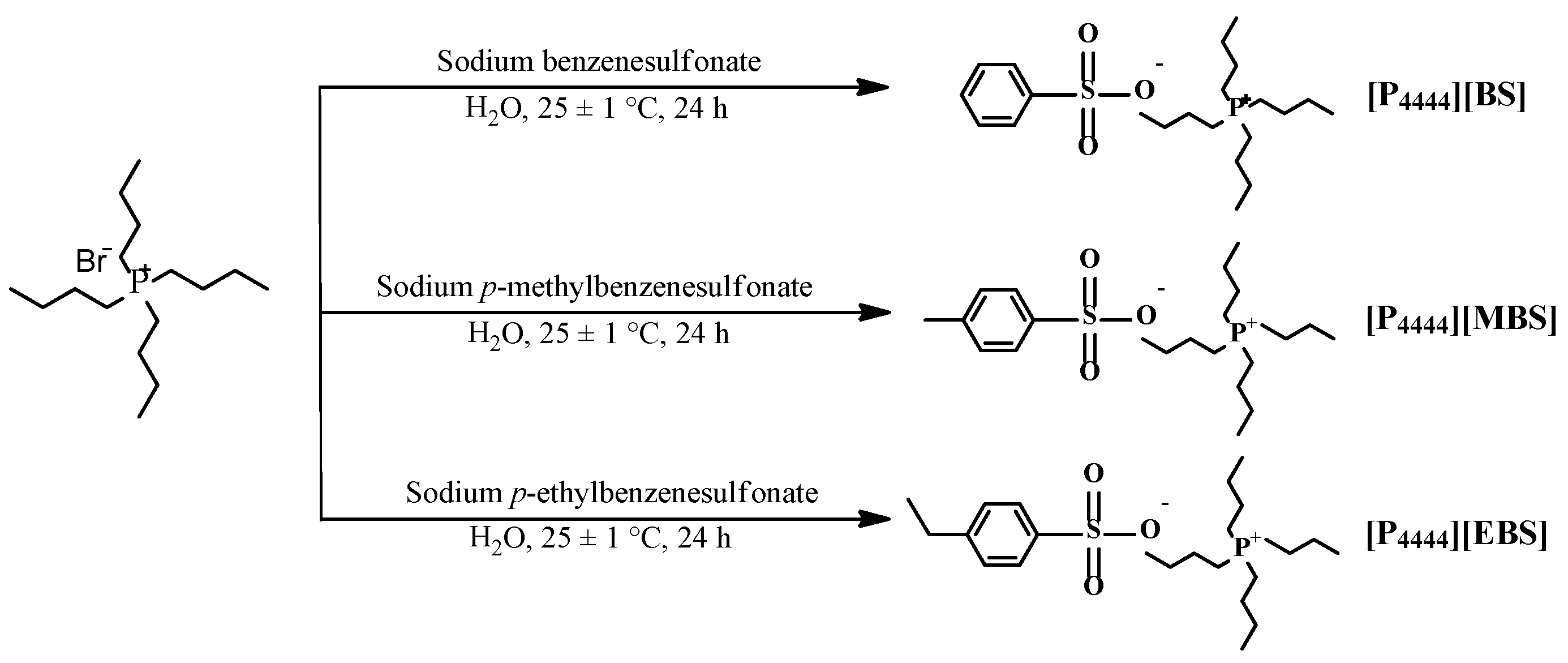
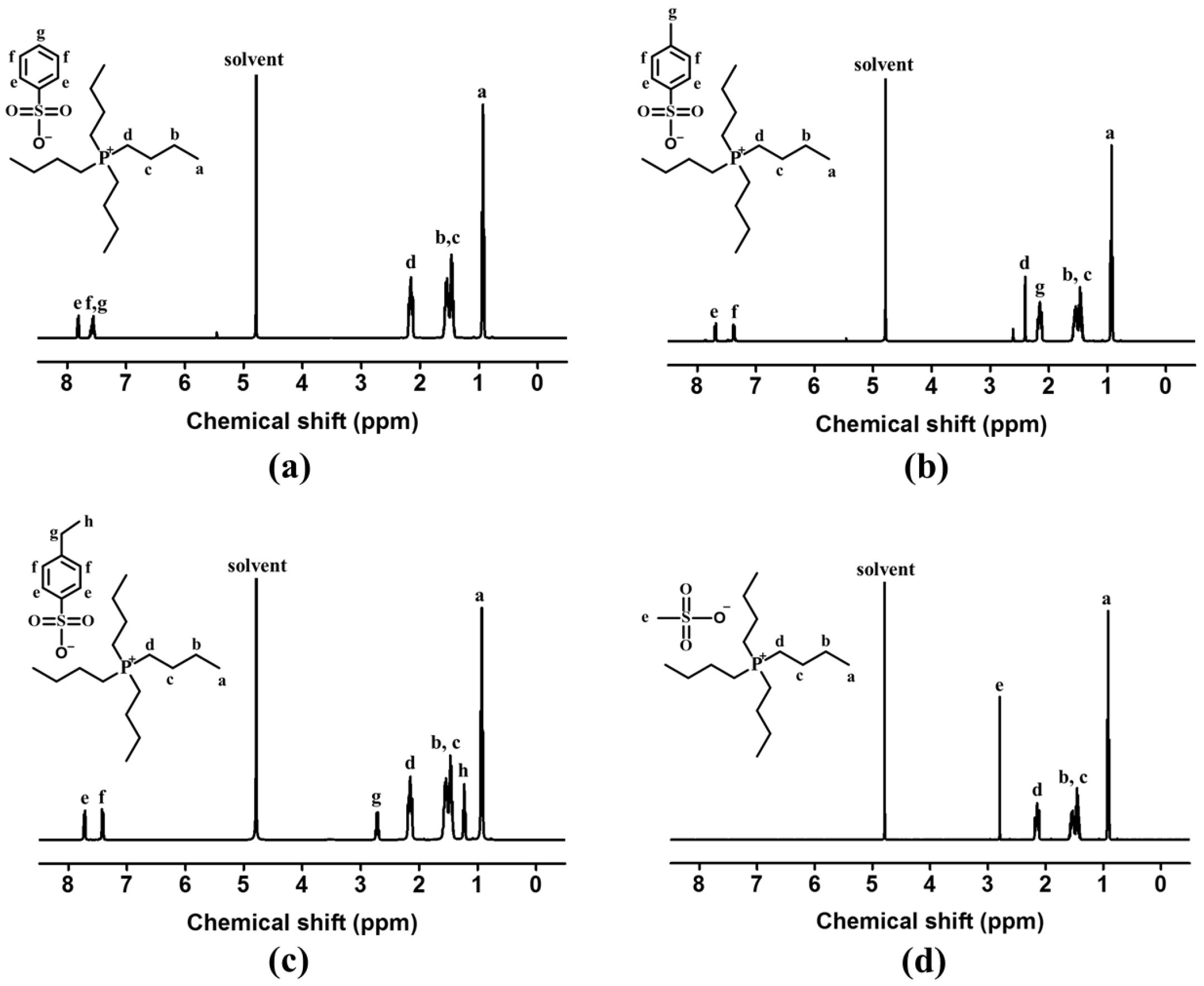
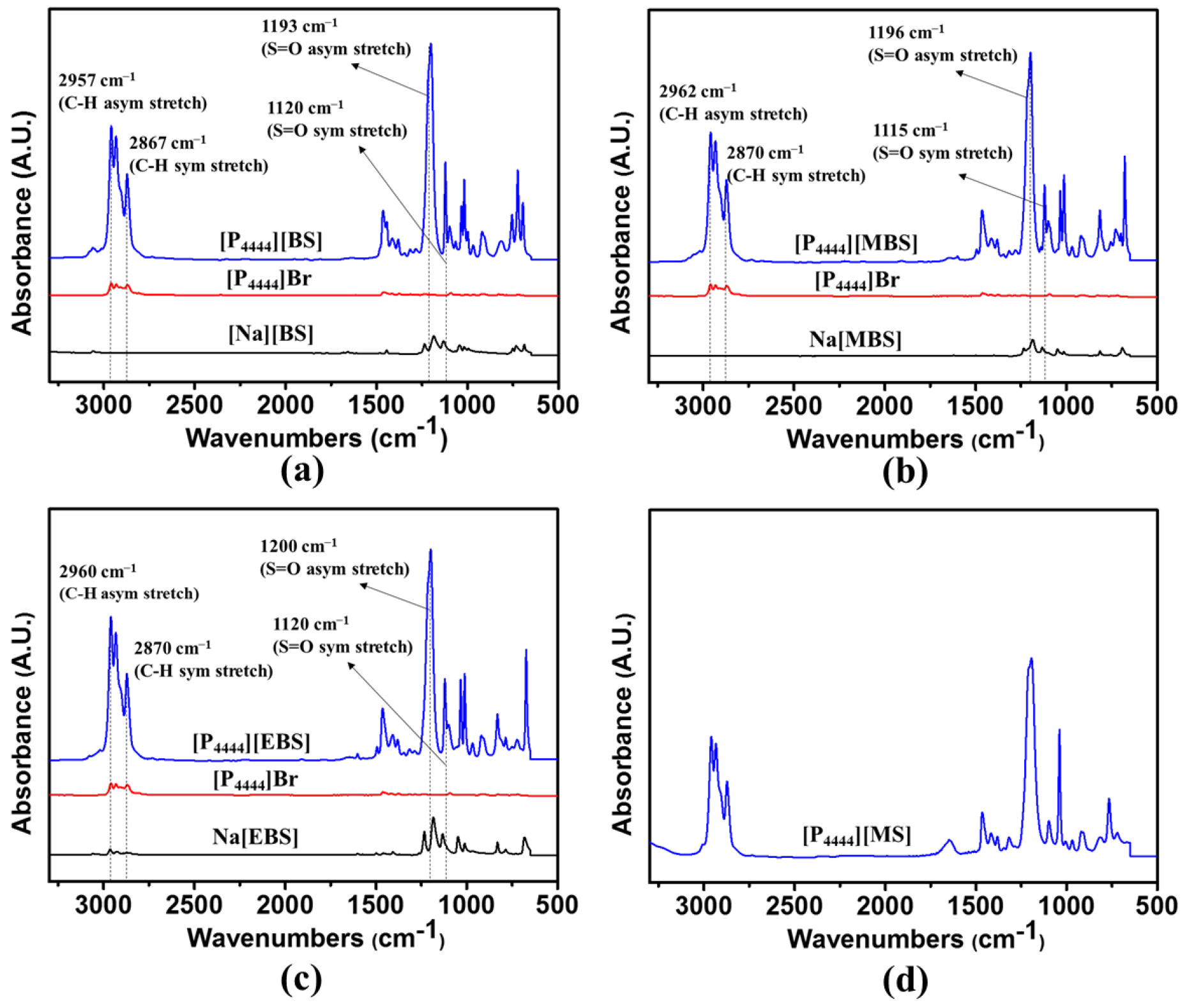
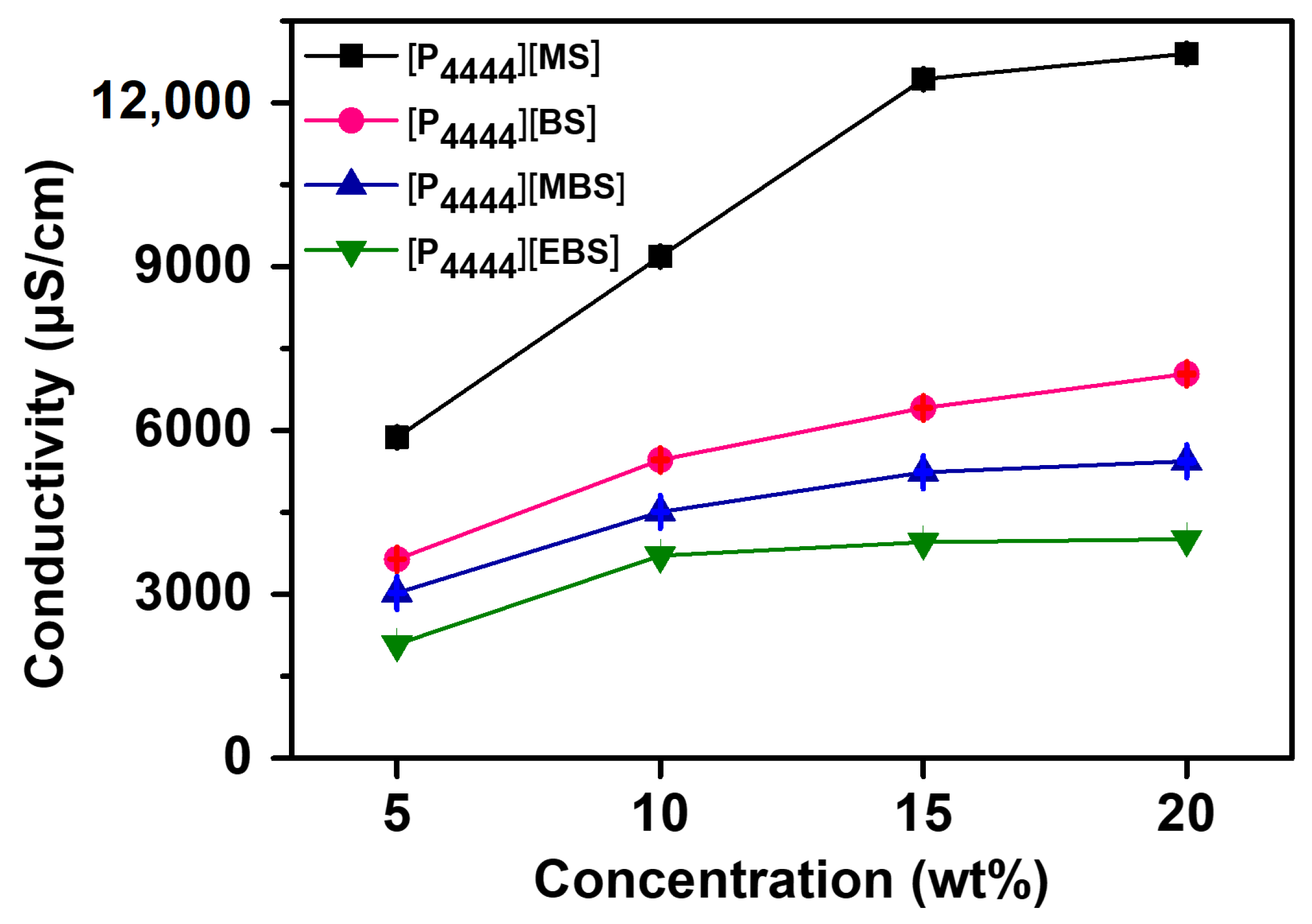
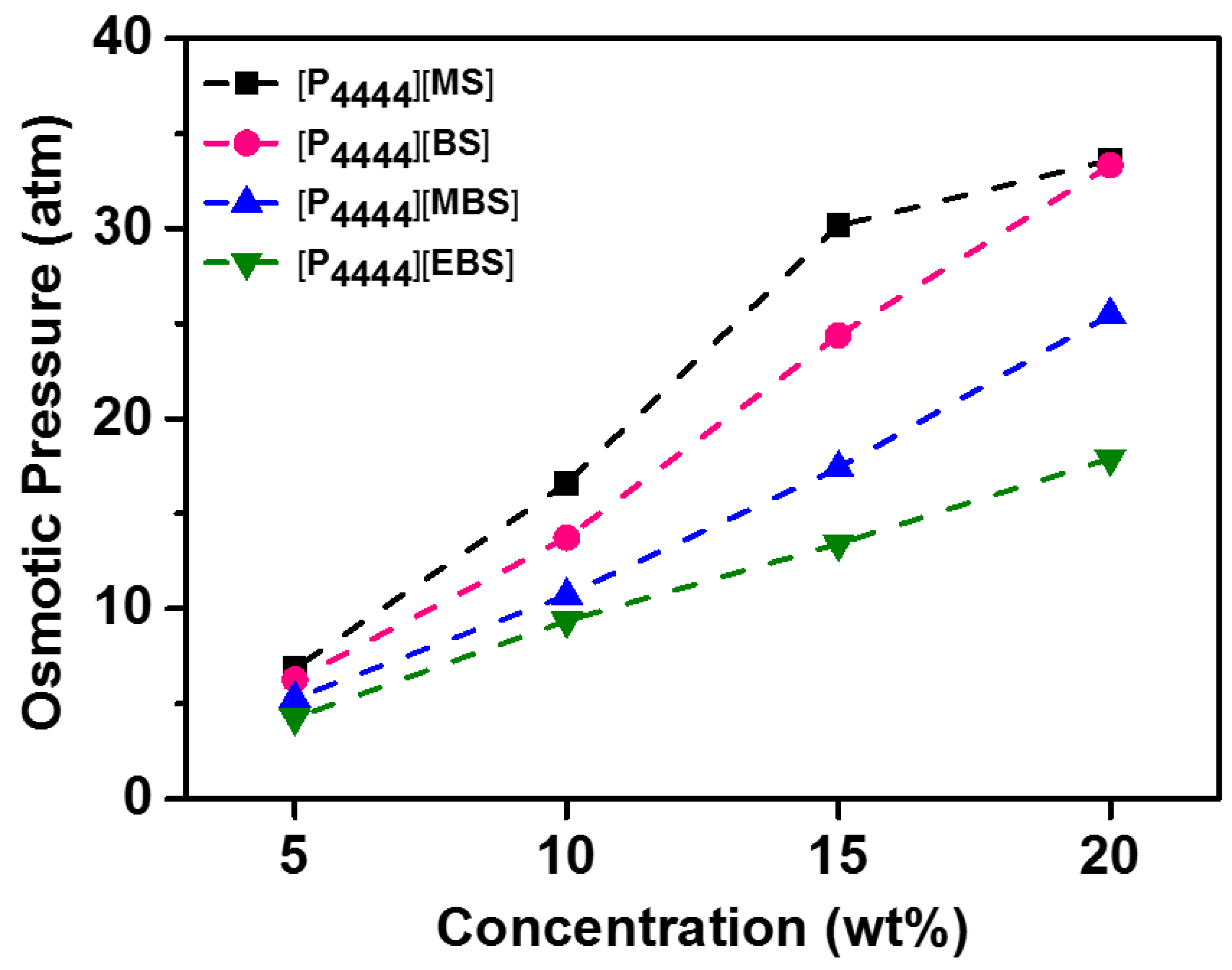



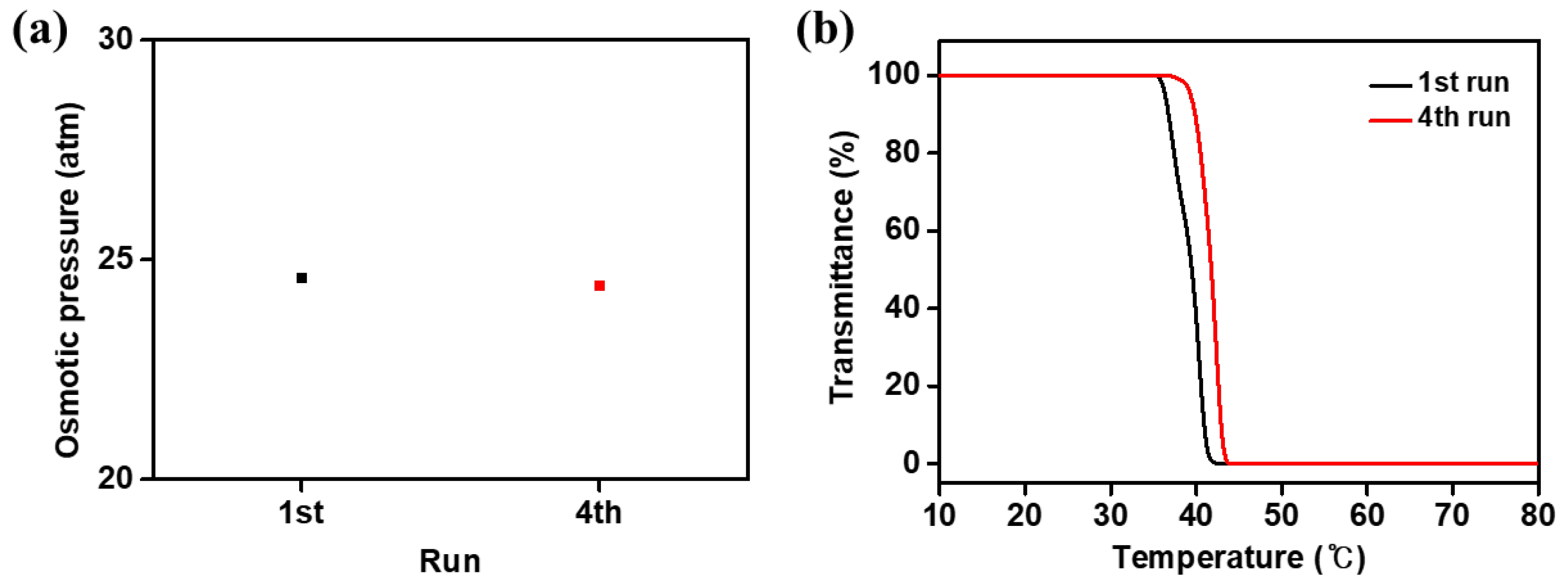
Disclaimer/Publisher’s Note: The statements, opinions and data contained in all publications are solely those of the individual author(s) and contributor(s) and not of MDPI and/or the editor(s). MDPI and/or the editor(s) disclaim responsibility for any injury to people or property resulting from any ideas, methods, instructions or products referred to in the content. |
© 2023 by the authors. Licensee MDPI, Basel, Switzerland. This article is an open access article distributed under the terms and conditions of the Creative Commons Attribution (CC BY) license (https://creativecommons.org/licenses/by/4.0/).
Share and Cite
Moon, J.; Kang, H. Anion Effect on Forward Osmosis Performance of Tetrabutylphosphonium-Based Draw Solute Having a Lower Critical Solution Temperature. Membranes 2023, 13, 211. https://doi.org/10.3390/membranes13020211
Moon J, Kang H. Anion Effect on Forward Osmosis Performance of Tetrabutylphosphonium-Based Draw Solute Having a Lower Critical Solution Temperature. Membranes. 2023; 13(2):211. https://doi.org/10.3390/membranes13020211
Chicago/Turabian StyleMoon, Jihyeon, and Hyo Kang. 2023. "Anion Effect on Forward Osmosis Performance of Tetrabutylphosphonium-Based Draw Solute Having a Lower Critical Solution Temperature" Membranes 13, no. 2: 211. https://doi.org/10.3390/membranes13020211
APA StyleMoon, J., & Kang, H. (2023). Anion Effect on Forward Osmosis Performance of Tetrabutylphosphonium-Based Draw Solute Having a Lower Critical Solution Temperature. Membranes, 13(2), 211. https://doi.org/10.3390/membranes13020211





